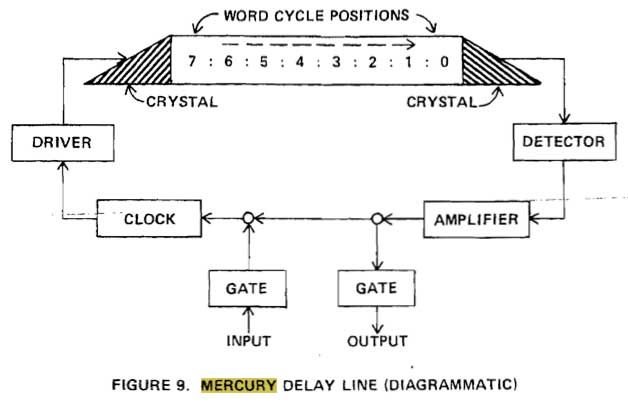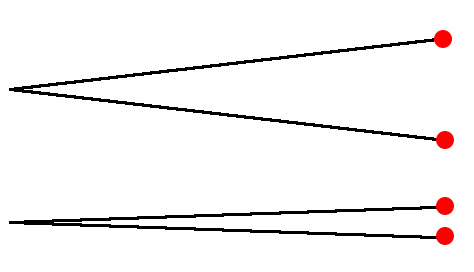Links and write-ups about beautiful things from around the web!
-
Abner Mercury Memory

From a recently declassified history (PDF) detailing the NSA’s computing equipment up to 1964, comes a description of their house-sized computer ABNER’s mercury-powered memory banks:
A succession of pulses (signal or no-signal) travels through an acoustic medium, say mercury, from one end to the other of a “delay line.” […] At the input end of the line is a crystal that converts an electrical pulse to a mechanical wave which travels through the mercury to the other end, where another crystal reconverts it to an electrical signal. The series of electrical signals is recirculated back to input, after passing through detector, amplifier, and driver circuits to restore the shape and strength of the pulses. Also, in the part of the cycle external to the delay line are input and output circuits and “clock” pulses for synchronization. In mercury, the pulses travel at the speed of sound, which is much slower than the speed of electrical signals, and thus the delay in going from one end of the line to the other constitutes a form of storage. […] In ABNER, the mercury tank was a glass tube about two feet long; the delay time was 384 microseconds, or eight words of 48 bits at one-megacycle-per-second rate. Thus the 1,024 words were contained in two cabinets holding 64 mercury delay lines each.
ABNER was named after comic strip character Li’l Abner, reportedly because it was a big, hulking machine that “didn’t know anything”.
(Via Bruce Schneier)
-
Bit Trip Runner
BIT.TRIP.RUNNER, one of the best games I’ve played this summer. A hypnotically synaesthetic music platformer, something like an inspired cross between Vib-Ribbon and Michel Gondry’s Star Guitar video. Well worth the few bucks if you’ve got a Wii.
(Seen above is a run of level 1-11 by YouTube user NintenDaan1, the level that I’m currently stuck playing over and over again trying to get all of the bonus gold…)
-
Michaelangelo Sistine Brain

From Concealed Neuroanatomy in Michelangelo’s Separation of Light From Darkness in the Sistine Chapel in the May, 2010, issue of Neurosurgery:
In the winter of 1511, Michelangelo entered the final stages of the Sistine Chapel project and painted 4 frescoes along the longitudinal apex of the vault, which completed a series of 9 central panels depicting scenes from the Book of Genesis. It is reported that Michelangelo concealed an image of the brain in the first of these last 4 panels, namely, the Creation of Adam. Here we present evidence that he concealed another neuronanatomic structure in the final panel of this series, the Separation of Light From Darkness, specifically a ventral view of the brainstem.
Could be pareidolia, but given Michelangelo’s breakthroughs in anatomical rendering and that God is depicted here with a rather non-standard bearded neck, who knows?
(Via NYTimes.com)
-
Everything Right Is Wrong Again Flexi-Disc
One great use of YouTube: watching long out-of-print vinyl flexidiscs warble out alternate takes on songs that I’ve been listening to for 20 years. This one is an early disc from They Might Be Giants, with a non-album version of “Everything Right is Wrong Again”.
-
The ‘Learning Knights’ of Bell Telephone
FIFTY-SIX years ago today, a Bell System manager sent postcards to 16 of the most capable and promising young executives at the company. What was written on the postcards was surprising, especially coming from a corporate ladder-climber at a time when the nation was just beginning to lurch out of a recession: “Happy Bloom’s Day.”
And so began a novel executive education program at Bell that brought a rapid-pace liberal arts education to many of their top engineers who previously had rarely cracked open a novel. They read heavier texts than the average grad student, attended cultural events, heard dozens of lectures from luminaries in the field, perused works as diverse as the Bhagavad-Gita and Babbitt, and the capstone was tackling the most challenging novel of the day, Ulysses. It was a success, and early reports indicated that it changed the workers’ lives. So how’d that turn out?
The institute was judged a success by Morris S. Viteles, one of the pioneers of industrial psychology, who evaluated its graduates. But Bell gradually withdrew its support after yet another positive assessment found that while executives came out of the program more confident and more intellectually engaged, they were also less interested in putting the company’s bottom line ahead of their commitments to their families and communities. By 1960, the Institute of Humanistic Studies for Executives was finished.
Oh.
-
Jamie Oliver Ted Talk
From Jamie Oliver’s TED talk urging us to teach our children about food, for the sake of ending our chronically poor (and ultimately fatal) eating habits:
For the last 7 years I’ve worked fairly tireless to save lives in my own way. I’m not a doctor. I’m a chef. I don’t have expensive equipment, or medicine. I use information and education.
-
iPad Classic
iPad Classic. Now we’re talkin’!
(Via El Reg)
-
Iphone Resolution

Phil Plait of Bad Astronomy lucidly explains display resolution, clearing up arguments about the iPhone 4’s retinal display technology:
Imagine you see a vehicle coming toward you on the highway from miles away. Is it a motorcycle with one headlight, or a car with two? As the vehicle approaches, the light splits into two, and you see it’s the headlights from a car. But when it was miles away, your eye couldn’t tell if it was one light or two. That’s because at that distance your eye couldn’t resolve the two headlights into two distinct sources of light.
The ability to see two sources very close together is called resolution.
DPI issues aside, the name “retinal display” is awfully confusing given that there’s similar terminology already in use for virtual retinal displays…
-
Digital Quantification of Human Eye Color
For those of you with eyes that aren’t easily categorized as simply “brown”, “blue”, or “hazel”: researchers have written up a new genetic model for human eye color phenotyping, published in PLoS Genetics.
We measured human eye color to hue and saturation values from high-resolution, digital, full-eye photographs of several thousand Dutch Europeans. This quantitative approach, which is extremely cost-effective, portable, and time efficient, revealed that human eye color varies along more dimensions than the one represented by the blue-green-brown categories studied previously. Our work represents the first genome-wide study of quantitative human eye color. We clearly identified 3 new loci, LYST, 17q25.3, TTC3/DSCR9, in contributing to the natural and subtle eye color variation along multiple dimensions, providing new leads towards a more detailed understanding of the genetic basis of human eye color.
(Via Nature)
-
A Macabre Fixation: Is Plastination Copyrightable?
I’ve actually wondered about this, as von Hagen’s popular (and assumed lucrative) Body Worlds exhibits have spawned many imitators of possibly questionable origins (one competing show is currently on view in a gallery inside our football stadium at the University of Texas). I guess that beyond the ethical and moral issues of consent and propriety, there’s also the business aspect: how enforceable is copyright when the primary medium is the deceased human body?
